Rapid scaling up of insecticide-treated bed net coverage in Africa and its relationship with development assistance for health: a systematic synthesis of supply, distribution, and household survey data
- PMID: 20808957
- PMCID: PMC2923089
- DOI: 10.1371/journal.pmed.1000328
Rapid scaling up of insecticide-treated bed net coverage in Africa and its relationship with development assistance for health: a systematic synthesis of supply, distribution, and household survey data
Abstract
Background: Development assistance for health (DAH) targeted at malaria has risen exponentially over the last 10 years, with a large fraction of these resources directed toward the distribution of insecticide-treated bed nets (ITNs). Identifying countries that have been successful in scaling up ITN coverage and understanding the role of DAH is critical for making progress in countries where coverage remains low. Sparse and inconsistent sources of data have prevented robust estimates of the coverage of ITNs over time.
Methods and principal findings: We combined data from manufacturer reports of ITN deliveries to countries, National Malaria Control Program (NMCP) reports of ITNs distributed to health facilities and operational partners, and household survey data using Bayesian inference on a deterministic compartmental model of ITN distribution. For 44 countries in Africa, we calculated (1) ITN ownership coverage, defined as the proportion of households that own at least one ITN, and (2) ITN use in children under 5 coverage, defined as the proportion of children under the age of 5 years who slept under an ITN. Using regression, we examined the relationship between cumulative DAH targeted at malaria between 2000 and 2008 and the change in national-level ITN coverage over the same time period. In 1999, assuming that all ITNs are owned and used in populations at risk of malaria, mean coverage of ITN ownership and use in children under 5 among populations at risk of malaria were 2.2% and 1.5%, respectively, and were uniformly low across all 44 countries. In 2003, coverage of ITN ownership and use in children under 5 was 5.1% (95% uncertainty interval 4.6% to 5.7%) and 3.7% (2.9% to 4.9%); in 2006 it was 17.5% (16.4% to 18.8%) and 12.9% (10.8% to 15.4%); and by 2008 it was 32.8% (31.4% to 34.4%) and 26.6% (22.3% to 30.9%), respectively. In 2008, four countries had ITN ownership coverage of 80% or greater; six countries were between 60% and 80%; nine countries were between 40% and 60%; 12 countries were between 20% and 40%; and 13 countries had coverage below 20%. Excluding four outlier countries, each US$1 per capita in malaria DAH was associated with a significant increase in ITN household coverage and ITN use in children under 5 coverage of 5.3 percentage points (3.7 to 6.9) and 4.6 percentage points (2.5 to 6.7), respectively.
Conclusions: Rapid increases in ITN coverage have occurred in some of the poorest countries, but coverage remains low in large populations at risk. DAH targeted at malaria can lead to improvements in ITN coverage; inadequate financing may be a reason for lack of progress in some countries. Please see later in the article for the Editors' Summary.
Conflict of interest statement
MM is employed by the US Centers for Disease Control and Prevention and is funded by the US President's Malaria Initiative.
Figures
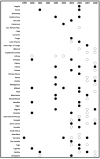
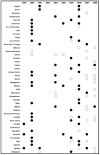



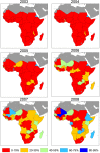
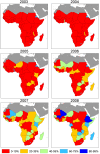
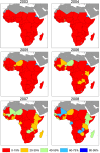
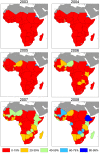


References
-
- WHO. World Malaria Report. Geneva: WHO; 2008.
-
- Ravishankar N, Gubbins P, Cooley RJ, Leach-Kemon K, Michaud CM, et al. Financing of global health: tracking development assistance for health from 1990 to 2007. Lancet. 2009;373:2113–24. - PubMed
-
- Snow RW, Guerra CA, Mutheu JJ, Hay SI. International Funding for Malaria Control in Relation to Populations at Risk of Stable Plasmodium falciparum Transmission. PLoS Med. 2008;5:e142. doi: 10.1371/journal.pmed.0050142. - DOI - PMC - PubMed
-
- Lengeler C. Insecticide-treated net bednet and curtains for preventing malaria. Cochrane Database Syst Rev. 2004;2:CD000363. doi: 10.1002/14651858.CD000363.pub2. - DOI - PubMed
-
- RBM Partnership. Global Strategic Plan: Roll Back Malaria 2005–2015. Geneva: RBM Partnership Secretariat; 2005.
Publication types
MeSH terms
LinkOut - more resources
Full Text Sources
Medical

